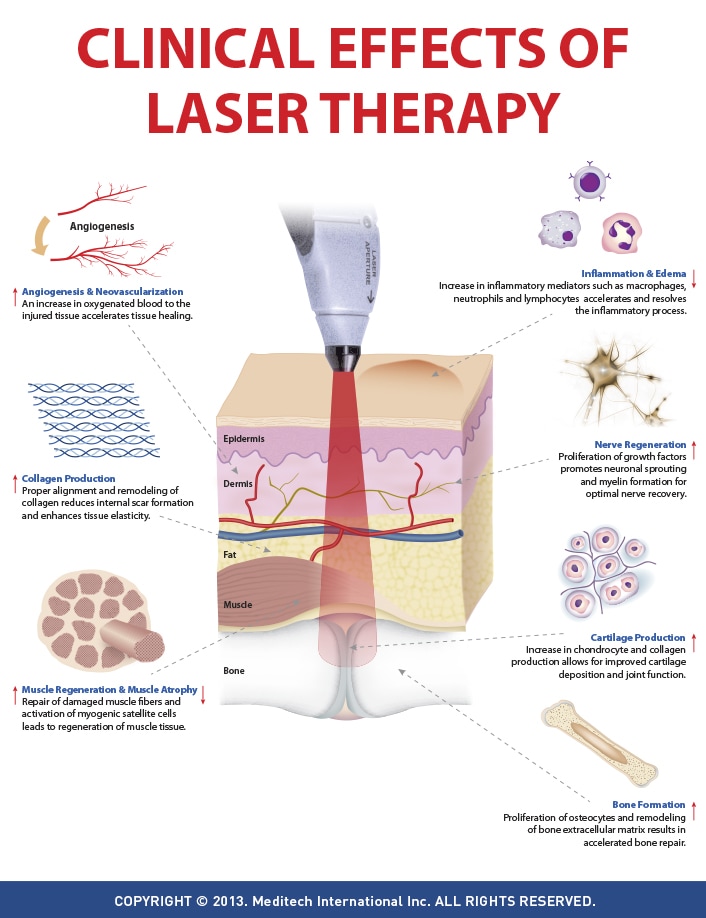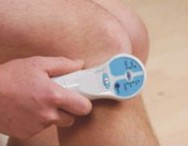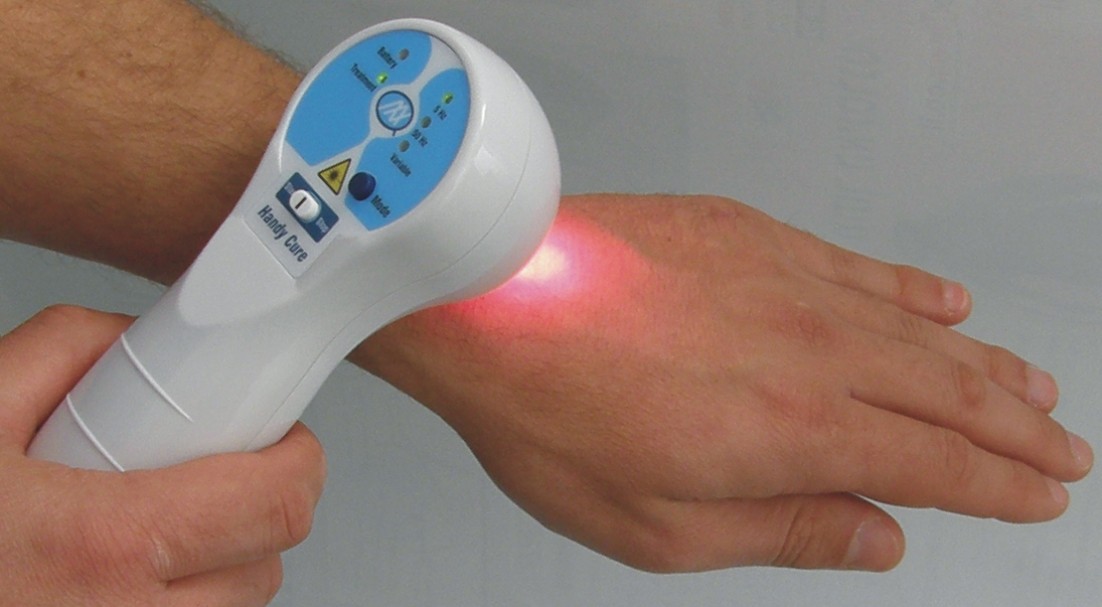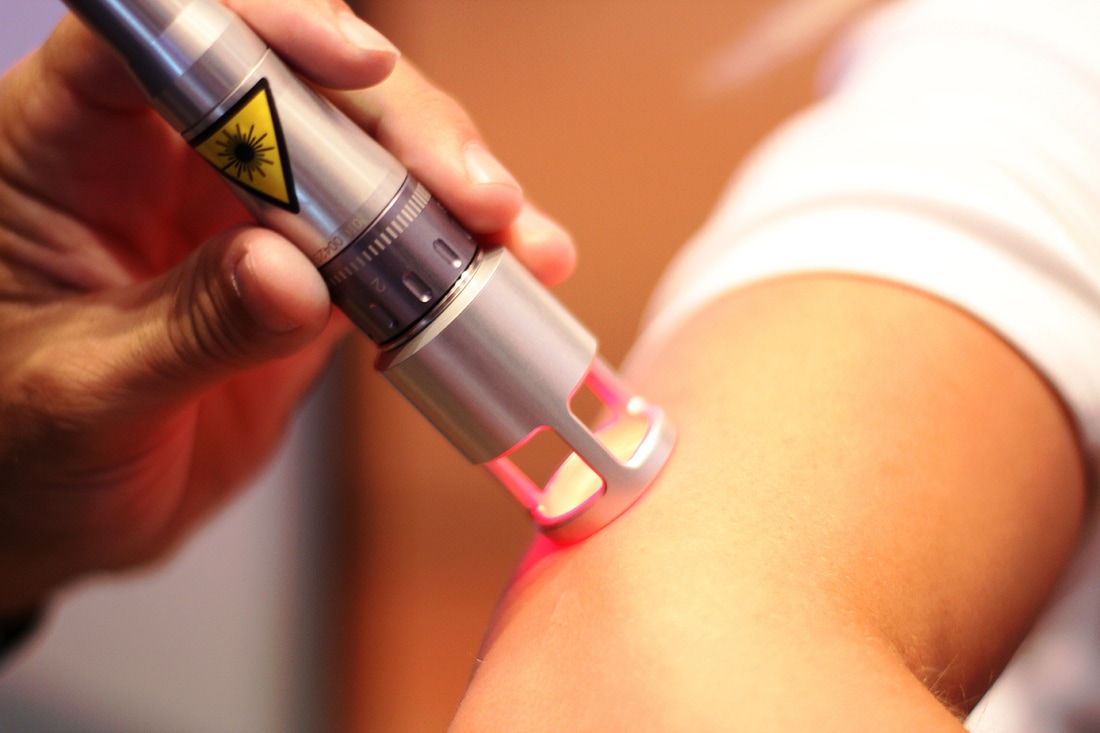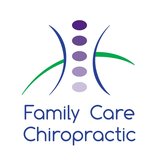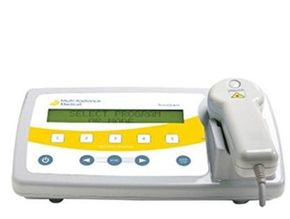 The word LASER is an acronym for Light Amplification by Stimulated Emission of Radiation. Cold Laser Therapy or Low Level Laser Therapy (LLLT) is a treatment that utilizes specific wavelengths of light to interact with tissue and is thought to help accelerate the healing process. It can be used on patients who suffer from a variety of acute and chronic conditions in order to help eliminate pain, swelling, reduce spasms, increase functionality, unblocking clogged arteries, eradicating infections, and other therapeutic purposes. Low Level Laser Therapy is often used interchangeably with the term "Cold Laser Therapy," meaning the laser does not produce heat, and is only therapeutic. It does not cut skin or intended to heat or burn skin. How Do Cold Lasers Work?There are many different types of cold laser devices. Many used by clinicians are often the size of a flashlight. and may be connected to a larger unit (computer), or may be a handheld device. The laser may be placed directly over the injured area for 30 seconds to several minutes depending on the size of the area being treated and the dose provided by the cold laser unit. Some may move the laser around, move the joint or muscle during treatment, and some may remain in contact without movement of either unit or patient. During treatment the non-thermal photons of light that are emitted from the laser and pass through the skin layers (the dermis, epidermis, and the subcutaneous tissue or tissue fat under the skin). This light has the ability to penetrate 2 to 5 centimeters below the skin. Once the light energy passes through the layers of skin and reaches the target area, it is absorbed and interacts with the light sensitive elements in the cell, such as the mitochondria. This process can be compared to photosynthesis in plants - sunlight is absorbed by plants, which is then converted to usable energy so that the plant can grow. The mitochondria absorbs the light, which is used to make energy in the form of ATP. When cells absorb this light energy, it also initiates a series of events that is theorized to eventually result in healing damaged or injured tissue. Some of these events include increasing the movement of immune cells from the blood vessels, into the area of tissue injury. Increase lymphatic flow and drainage, as well as increased blood flow and drainage can occur. In short, laser therapy can assist in reduction of pain, inflammation, edema and an overall reduction in healing time by increasing intracellular metabolism. What conditions can cold laser help?Cold laser therapy can stimulate all cell types including muscle, ligament, cartilage, and nerves, so a number of conditions can be treated by cold laser therapy. Some conditions improved or treatment aided by cold laser therapy include: Dr. Diana's Experience with LaserI knew right away the I wanted to incorporate laser therapy in my practice based on my experiences with laser, both personal and professional. I first learned about laser therapy when I worked in the veterinary industry. After attending an 8 hour lecture on laser use in animals I was intrigued. Lasers were being used to help heal surgical incisions and fractures, treat ear infections and abscesses, and decrease pain in animals with disc injuries and arthritis. Laser therapy was new, and it was exciting to be on the cutting edge of using such advanced technology. While at Logan some students weren't quite as impressed with the technology and to be honest, other than seeing it used in animals. I hadn't experienced laser therapy for myself until my last year at Logan, the year that we get to treat patients that aren't students, I broke my arm. I immediately researched treatments that would be helpful and laser was one. I was given some pretty intense pain medications, and I didn't want to take them. I used laser therapy to treat my pain, and after three days, I no longer needed pain medications. I used laser therapy to help manage pain, and accelerate healing. My fracture was healed in 6 weeks, and while typical healing time is 6-8 weeks, I appreciated the shorter time frame. I was fortunate that as a student without insurance, I was in the right place at the right time as we able to get the care I need at school, with little intervention aside from a trip to the emergency room. If your curious, I also used massage therapy, essential oils, nutritional modification, and chiropractic care as part of my recovery. Dr. JC Maier, who now practices at Convergence Dance and Body Center in Brentwood was my student intern at the time and did a great job taking care of me. Another time I personally used laser therapy was when I injured my knee. I ended up driving up to Virden, IL for BioMat Infrared Therapy training with Dr. Todd Austin. While my massage therapist had initially introduced me to BioMat Infrared Therapy, Dr. Austin is the local authority on their use and introduced me to the full length mat. After 20 minutes on the mat, my knee pain had decreased by 80%. Using a combination of laser and infrared therapy with BioMat, I was able to treat myself in my own office to heal my knee. Is Laser Therapy Right for You?Who should NOT get laser therapy?
Any provider should go over the benefits, risks, and alternatives to laser therapy. Informed consent should always be obtained prior to treatment. The provider should be knowledgeable of these, and assess a person's health, contraindications and appropriateness of treatment prior to treating.
If you are curious about laser therapy to help with a condition, my best advice would be to schedule a consultation with a provider. Laser therapy may be an option alone, or in combination with other modalities such as chiropractic, essential oils, infrared heat therapy with a BioMat, nutritional modification, etc. I rarely use laser therapy alone to treat patients, but other providers may treat differently. I have had to tell individuals that I didn't think laser would be appropriate for their condition due to inaccurate diagnosis, scope of practice, or due to the severity of their condition other interventions were more appropriate. An appropriate diagnosis is important when deciding laser therapy. Comments are closed.
|
Location |
HoursMonday: 9 am - 12 pm & 2 pm - 6 pm
Tuesday: By Appointment Only Wednesday: 9 am - 12 pm & 2 pm - 6 pm Thursday: 9 am - 12 pm & 2 pm - 6 pm Friday: 9 am - 12 pm & 2 pm - 6 pm Saturday and Sunday: Closed |
|

